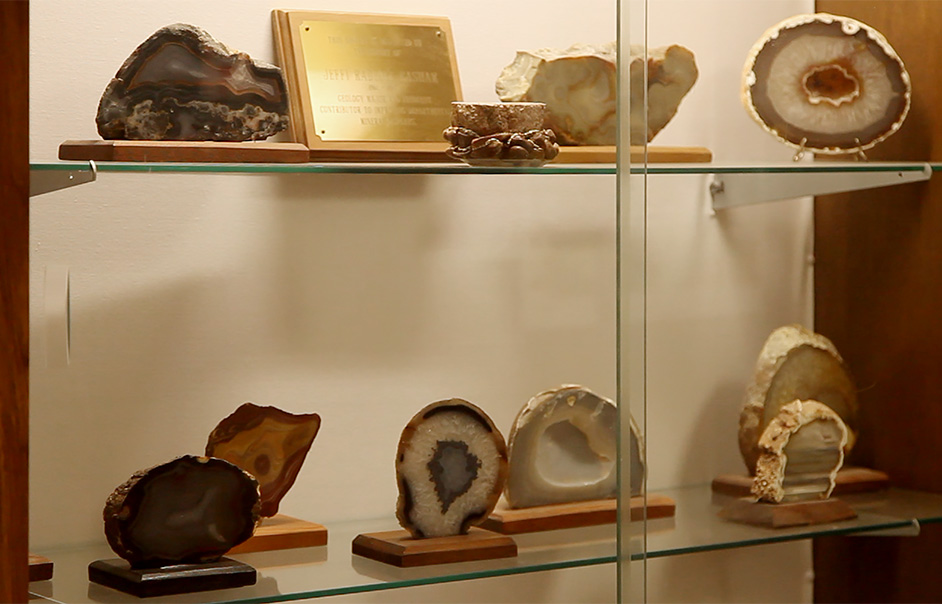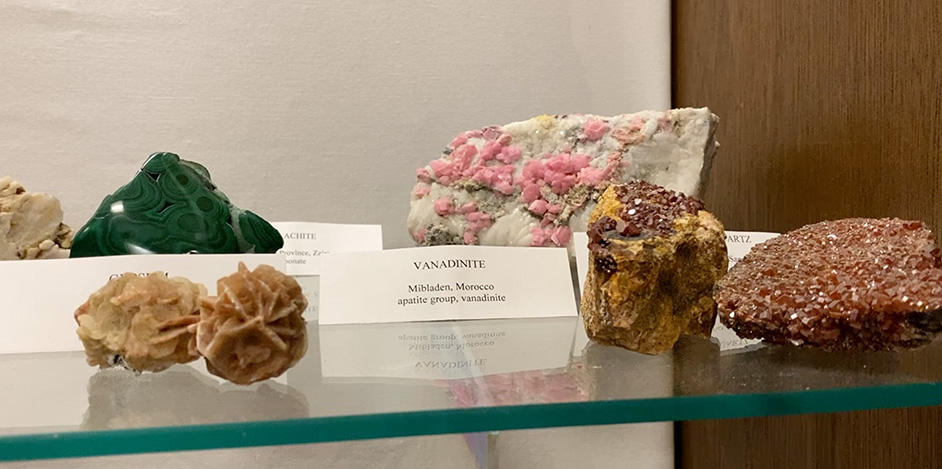Earth and Atmospheric Sciences Department Houses About 600 Rocks and Minerals
Among the halls of the Science and Research 1 building, hundreds of rock and mineral samples line the walls in glass cases.

University of Houston instructional professor of geology Jinny Sisson oversees the display cases for the College of Natural Sciences and Mathematics’ Department of Earth and Atmospheric Sciences.
She estimates there are 600 samples, although she has never taken a full inventory of the items. You can find them on the second and third floors of the college’s SR 1 building, and in the Lamar Fleming, Jr. building on the second floor and in the Geoscience Learning Center, also in the Fleming building.
Sisson took it upon herself to fix the displays after she was hired 13 years ago.
“I immediately noticed the display cases were in terrible shape,” she said. “They were very dusty. I had a few teaching assistants volunteer to clean them, because I noticed any time an undergraduate was waiting for a professor, they were looking at the cases. And I did not want them looking at dusty, dirty cases.”
The cases are now maintained by geology Ph.D. student Shelby Johnston.
“I had one semester where I was a curator for the department,” Johnston said. “That was my job as a teaching assistant. I had to create educational displays. Since then, I have kept up with the cases, sort of volunteering time here and there to make sure they stay clean.”
The Origin of the Samples
Sisson said she does not know where exactly all the rocks and minerals originated from but was told they have been at UH since Science and Research 1 was built.
“Initially, each faculty member got a shelf and filled them with their own research,” said Sisson. “There’s only one of those left. Dr. Rosalie Maddox has one dedicated to fossils. And that’s more for introductory students than her research.”
Two hundred samples were donated by Jim Gibson eight years ago, a friend of Sisson’s husband who worked at ExxonMobil.

She explains Gibson started collecting as a child in New Jersey and continued to grow his collection as an undergraduate at Rutgers. Eventually, he filled his home with samples but decided to downsize to a smaller house and was interested in loaning his samples for others to admire and learn from.
Most of the samples he loaned to UH consist of the mineral prehnite.
“It’s a mineral that grew in New Jersey in the Triassic time,” about 250 to 200 million years ago, said Sisson. “It was a response to the opening up of the Atlantic Ocean. When a new ocean floor was formed, hot water circulated and formed the prehnite, as well as some other minerals.”
Because the ocean was shallow at the time, salt crystals formed. The salt has since evaporated and dissolved away from the rocks, but a cast from the salt crystals can still be seen on the mineral.
Gibson also loaned a sample of velociraptor footprints and the footprint of an unknown, large, three-toed dinosaur.
Displays Bolster Geologic Education
The plethora of samples on display add to the education students receive in their coursework. Geology and geophysics students, Johnston said, learn about rocks and minerals in multiple classes.
“Physical geology is our introductory course,” she said. “Most of the items in our display cases are minerals, so they learn about those in minerology, which is a class dedicated to teaching the chemistry of mineral structures.”
If students want to learn about rocks, the department offers multiple classes. One for igneous rocks, metamorphic rocks and another one for sedimentary rocks. There is also a separate class that teaches them about fossils – paleontology.
“People should learn from the minerals,” said Sisson. “If nothing else, they should see the wonders of the earth. Even if they do not understand what they are, they can still appreciate them. And they don’t have to go to a museum.”
- Rebeca Trejo, College of Natural Sciences and Mathematics